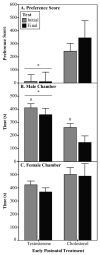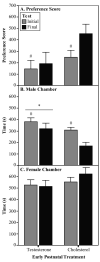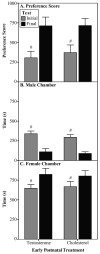Exogenous androgen during development alters adult partner preference and mating behavior in gonadally intact male rats
- PMID: 20171967
- PMCID: PMC2875074
- DOI: 10.1016/j.yhbeh.2010.02.007
Exogenous androgen during development alters adult partner preference and mating behavior in gonadally intact male rats
Abstract
In the rat, neonatal administration of testosterone propionate to a castrated male causes masculinization of behavior. However, if an intact male is treated neonatally with testosterone (hyper-androgen condition), male sexual behavior in adulthood is disrupted. There is a possibility that the hyper-androgen treatment is suppressing male sexual behavior by altering the male's partner preference and thereby reducing his motivation to approach the female. If so, this would suggest that exposure to supra-physiological levels of androgen during development may result in the development of male-oriented partner preference in the male. To test this idea, male rats were treated either postnatally or prenatally with testosterone, and partner preference and sexual behavior were examined in adulthood. The principal finding of this study was that increased levels of testosterone during early postnatal life, but not prenatal, decreased male sexual behavior and increased the amount of time a male spent with a stimulus male, without affecting the amount of time spent with a stimulus female during partner preference tests. Thus, the reduction in male sexual behavior produced by early exposure to high levels of testosterone is not likely due to a reduction in the male's motivation to approach a receptive female.
Published by Elsevier Inc.
Figures



Similar articles
-
Estrogen treatment during development alters adult partner preference and reproductive behavior in female laboratory rats.Horm Behav. 2009 Jan;55(1):68-75. doi: 10.1016/j.yhbeh.2008.08.009. Epub 2008 Aug 28. Horm Behav. 2009. PMID: 18793640 Free PMC article.
-
Sexual behaviour of neonatally castrated rats injected during infancy with oestrogen and dihydrotestosterone.J Endocrinol. 1977 Feb;72(2):135-41. doi: 10.1677/joe.0.0720135. J Endocrinol. 1977. PMID: 845532
-
Adult partner preference and sexual behavior of male rats exposed prenatally to betamethasone.Physiol Behav. 2009 Aug 4;98(1-2):163-7. doi: 10.1016/j.physbeh.2009.05.003. Epub 2009 May 18. Physiol Behav. 2009. PMID: 19454291
-
Steinach and Young, Discoverers of the Effects of Estrogen on Male Sexual Behavior and the "Male Brain".eNeuro. 2015 Nov 17;2(6):ENEURO.0058-15.2015. doi: 10.1523/ENEURO.0058-15.2015. eCollection 2015 Nov-Dec. eNeuro. 2015. PMID: 26601123 Free PMC article. Review.
-
The neurobiology of sexual partner preferences in rams.Horm Behav. 2009 May;55(5):611-20. doi: 10.1016/j.yhbeh.2009.03.013. Horm Behav. 2009. PMID: 19446078 Free PMC article. Review.
Cited by
-
Digit Ratio (2D:4D; Right-Left 2D:4D) and Multiple Phenotypes for Same-Sex Attraction: The BBC Internet Study Revisited.Arch Sex Behav. 2024 Jan;53(1):213-222. doi: 10.1007/s10508-023-02703-6. Epub 2023 Oct 17. Arch Sex Behav. 2024. PMID: 37847344 Free PMC article.
-
Neural and Hormonal Basis of Opposite-Sex Preference by Chemosensory Signals.Int J Mol Sci. 2021 Aug 2;22(15):8311. doi: 10.3390/ijms22158311. Int J Mol Sci. 2021. PMID: 34361077 Free PMC article. Review.
-
Using Animal Models to Study the Interplay Between the Biodevelopmental Pathways Underlying Human Sexual Orientation.Arch Sex Behav. 2023 Oct;52(7):2979-2984. doi: 10.1007/s10508-022-02499-x. Epub 2022 Dec 7. Arch Sex Behav. 2023. PMID: 36477673 No abstract available.
-
Sexuality and gender role in autism spectrum disorder: a case control study.PLoS One. 2014 Jan 31;9(1):e87961. doi: 10.1371/journal.pone.0087961. eCollection 2014. PLoS One. 2014. PMID: 24498228 Free PMC article. Clinical Trial.
-
Sexual partner preference in animals and humans.Neurosci Biobehav Rev. 2020 Aug;115:34-47. doi: 10.1016/j.neubiorev.2020.03.024. Epub 2020 May 22. Neurosci Biobehav Rev. 2020. PMID: 32450091 Free PMC article. Review.
References
-
- Adkins-Regan E. Sex hormones and sexual orientation in animals. Psychobiology. 1988;16(4):335–347.
-
- Bakker J. Sexual differentiation of the neuroendocrine mechanisms regulating mate recognition in mammals. Journal Of Neuroendocrinology. 2003;15(6):615–621. - PubMed
-
- Bakker J, vanOphemert J, Slob AK. Sexual differentiation of odor and partner preference in the rat. Physiology & Behavior. 1996;60(2):489–494. - PubMed
-
- Bakker J, Vanophemert J, Timmerman MA, Dejong FH, Slob AK. Endogenous reproductive hormones and nocturnal rhythms in partner preference and sexual behavior of ATD-treated male rats. Neuroendocrinology. 1995;62(4):396–405. - PubMed
-
- Baum MJ. Differentiation Of Coital Behavior In Mammals - Comparative-Analysis. Neuroscience And Biobehavioral Reviews. 1979;3(4):265–284. - PubMed
Publication types
MeSH terms
Substances
Grants and funding
LinkOut - more resources
Full Text Sources

